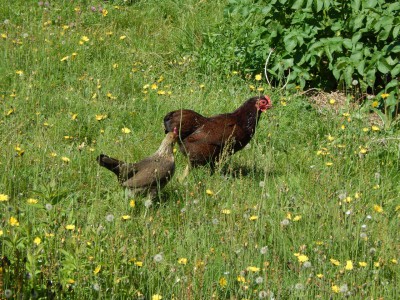Managing Meadows and Lawns for Beauty and Biodiversity
by Heather McCargo
MEADOWS
In the summertime, meadows are buzzing with life. Vegetation is tall and verdant, many species of flowering plants are blooming, and sex and child rearing are in full swing among plants and animals. A meadow is a rich habitat for so many creatures.
In Maine, many of the common plant species we see in meadows – dandelion, clover, buttercup, oxeye daisy, timothy and orchard grass are Eurasian imports that came over several hundred years ago with the first colonists. The natives that you may recognize are violets, bluets, blue-eyed grass, wild geranium, strawberry, milkweed, spirea, black-eyed coneflower, asters, and goldenrod. (The lupines that are so beloved in Maine are actually garden escapes from the Pacific Northwest of the US).
This is the worst time to cut grass and flowers if you want to encourage local biodiversity, yet this is when many meadows and roadsides are routinely mowed, instantly wiping out habitat and reproduction for so many wild species. When a field is mowed, flowers are cut off before producing their seeds and animals are either killed or forced to abandon their homes. Reproduction of the desirable plants and animals is arrested, once again setting the odds against the native biodiversity.
If you are growing a crop of hay, this is indeed the right time to mow. If you have aggressive invasive plants such as crown vetch, bittersweet or Japanese knotweed, mow these patches repeatedly to set them back and to prevent them from going to seed.
But if you want to support the native plants, pollinating insects, birds and many other creatures that make this habitat their home, changing your mowing routine will benefit native species while still preventing your meadow from reverting to forest. To promote native plant flowering and reproduction, mowing can be delayed until late fall, after the last asters have released their seeds.
A recommended strategy for protecting plants, pollinating insects, and the habitat for birds, reptiles and mammals is to stagger the mowing so that all the meadow doesn’t disappear at the same time. Divide your meadow into two or more zones so that you have unmown sections somewhere at all times, including winter when many native species live in the dead stems and leaves of plants.
A mown path winding through your meadow will make it easy to get out and enjoy this dynamic habitat.
LAWNS
Lawn grasses can also be managed in a more relaxed way that benefits native biodiversity.
Lawns are useful. No other plant can be walked on as heavily as turf grass. Look at your yard and think about where you need an outdoor carpet or pathway and keep this mowed regularly, as you like. Use a mulch setting on your mower (unless you are having a party or lots of visitors and don’t want the clippings tracked in the house) and manage your lawn organically (see more organic lawn care ideas).
If the grass seems thin, top dress with compost or add clover seed. Or embrace the space between areas of grass and add small wildflowers. Dry lawns can be filled in with bluets, wild strawberry, blue-eyed grass, rock phlox, low bush blueberry, and pussytoes. Shady lawns can be converted to a woodland understory with groundcovers such as violets, ferns, Jacob’s ladder, golden groundsel, wood phlox, wild ginger, wild geranium, bunchberry or many others. For more planting ideas, please see our Comprehensive Plant List.
If your lawn is expansive, identify areas that can be mowed less often, therefore creating a more protective habitat and diversity of flower forage for birds and pollinators. This low-maintenance lawn can be mowed once a month or once a season.
Be modest in your mowing and watch nature return.
 AN OBSERVATION ON TICKS AND CHICKENS
AN OBSERVATION ON TICKS AND CHICKENS
Chickens love to eat insects. I have let my chickens forage in my yard for years and find they are an effective way to reduce the tick population around my house. So to help control ticks, give a home to a couple of retired hens or an unwanted rooster and let them free range in your yard.
More information:
Native Gardening Blog
After removing disruptive introduced species, try planting these
Join Our Team!
Landscaping in partnership with native ecosystems is good for the planet. It’s good for us too.
Building Biodiverse & Climate-Resilient Habitats
Supporting Ash Protection Collaboration Across Wabanakik

